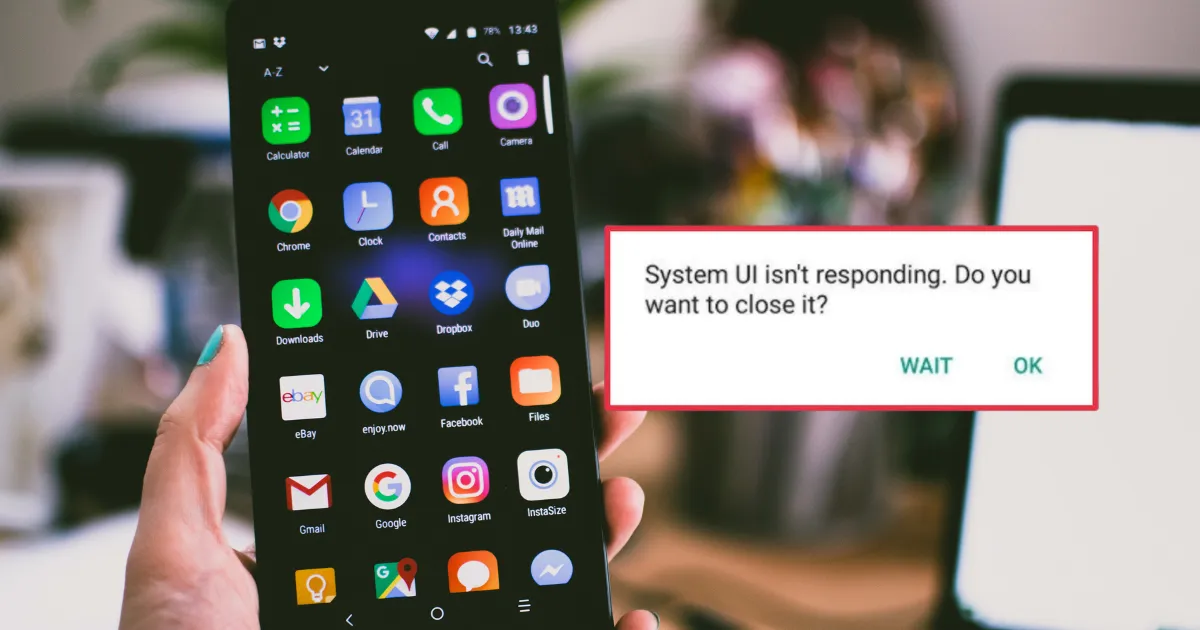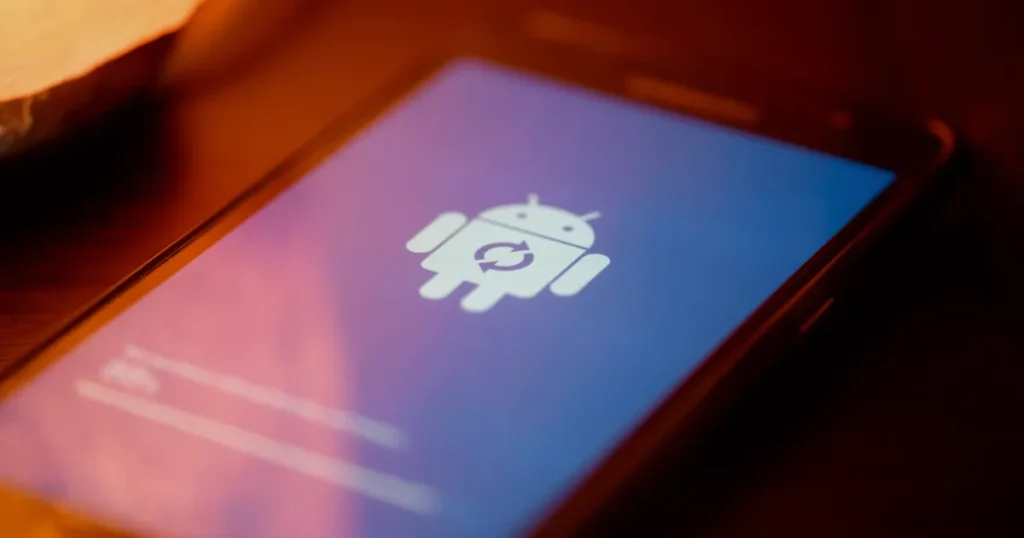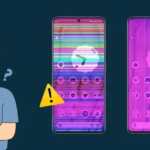How to Fix Android System UI Not Responding (6 Proven Way)
Description

Are you struggling with “Android system UI not responding” errors on your device?
This frustrating message indicates that the User Interface (UI) essential for using your Android phone has ceased to function properly, affecting models across the board including those running on Android 11 and Android 12, and brands like Motorola and Samsung.
We understand how crucial a smooth, responsive UI is for your daily mobile experience and have outlined actionable troubleshooting methods to resolve this issue effectively.
From understanding what System UI is on your Android phone to preventing future errors, we promise a comprehensive approach to solving the ‘system UI not responding’ dilemma for you.
Table of Contents
Common Causes of the ‘Android System UI Not Responding’ Error
Identifying the Culprits Behind System UI Failures
- App Conflicts and Updates
- Conflicts due to recently updated apps can cause the ‘System UI not responding’ error. Sometimes, app updates are not fully compatible with the current OS, leading to instability in the system’s UI.
- Insufficient Storage Space
- A lack of available storage on your device can hinder the operating system’s ability to function properly, potentially causing errors in the System UI.
- Corrupted System Files
- Corruption within system files or essential app malfunctions can be significant contributors to System UI issues. This corruption can stem from failed updates, system crashes, or malware.
- Outdated or Faulty Firmware
- Running outdated system firmware, or having a corrupted OS installation, including issues with the SD card or external storage, can lead to this error. It’s crucial to ensure that your device’s firmware is up-to-date and functioning correctly.
- Problematic Third-Party Apps
- Installing apps from unknown sources or having pending updates from incompatible apps can disrupt the normal functioning of System UI. It’s advisable to only install trusted applications and keep them updated.
- Memory and Resource Access Issues
- Errors can also arise when apps attempt to access system resources without proper permissions, or if there’s improper insertion of memory cards which can disrupt the system processes.
Troubleshooting Steps to Identify Specific Issues
- Check for App Updates: Ensure that all apps, especially system apps, are up-to-date.
- Review Storage Availability: Clear up space if your device’s storage is nearly full.
- Scan for Malware: Use a reliable antivirus to check for malware that might be causing the system to halt.
- Inspect External Storage: Make sure that any SD card or external storage is correctly formatted and functioning properly.
By addressing these common causes, you can better diagnose and resolve the ‘System UI not responding’ issue on your Android device.
Android System UI Not Responding Troubleshooting Methods

Restart Your Device
- Initial Quick Fix: Often, a simple restart can resolve minor glitches causing the “System UI not responding” error. To restart:
- Press and hold the power button.
- Select ‘Restart’ from the options that appear on the screen.
Update or Uninstall Apps
- Update Your Apps: Keeping your apps updated is crucial as outdated apps can lead to system errors.
- Navigate to Google Play Store.
- Go to ‘My apps & games’, then update all available apps.
- Uninstall Problematic Apps: If you suspect a recently installed app is causing issues:
- Go to ‘Settings’ > ‘Apps’.
- Select the suspicious app and tap ‘Uninstall’.
Clear Cache and Data
- Google App and System UI Cache:
- Navigate to ‘Settings’ > ‘Apps’ > ‘Google App’.
- Tap on ‘Storage’ > ‘Clear cache’. Repeat for ‘System UI’ under ‘Show system applications’.
Advanced Solutions
- Safe Mode and Factory Reset:
- Enter Safe Mode: Restart your phone and hold down the volume down button during startup to diagnose third-party app conflicts.
- Factory Reset: As a last resort, back up your data and then go to ‘Settings’ > ‘System’ > ‘Reset options’ > ‘Erase all data (factory reset)’.
Use Specialized Tools
- Using DroidKit:
- Download and install DroidKit.
- Connect your device and use the tool to fix the UI not responding issue without root.
Managing Device Settings
- Reset App Preferences and Wipe Cache Partition:
- For app preferences, go to ‘Settings’ > ‘System’ > ‘Reset options’ > ‘Reset app preferences’.
- To wipe the cache partition, reboot into recovery mode, and select ‘Wipe cache partition’.
By methodically following these steps, you can tackle the “System UI not responding” error effectively, ensuring a smoother experience with your Android device.
Preventative Measures to Avoid Future UI Errors
Maintain Adequate Storage
- Free Up Space: Ensure your Android device maintains at least 1.5GB to 2GB of free storage to prevent UI errors. Regularly delete unnecessary files or use storage management tools to keep your device optimized.
Regular Updates
- System and App Updates: Keep your Android OS and all applications up to date. Updates often include bug fixes that can prevent system UI errors.
- Check for updates in ‘Settings’ > ‘System’ > ‘System updates’.
- Update apps via Google Play Store under ‘My apps & games’.
Manage External Storage
- SD Card Maintenance: Properly manage and occasionally remove SD cards to ensure they are not corrupting the System UI.
- Eject SD cards safely by going to ‘Settings’ > ‘Storage’ > ‘Unmount SD card’.
Monitor New Installations
- App Installation Oversight: Be vigilant about the sources of your app downloads and the permissions they require. Avoid installing apps that are not from trusted sources.
Use Browser Protection
- Malware Prevention: Utilize browser protection software like Guardio to shield against malware that could cause UI errors.
Regular Cache and Data Management
- Clear Cache and Data Regularly: Keep your system UI running smoothly by clearing cache partitions and data.
- Navigate to ‘Settings’ > ‘Storage’ > ‘Cached data’ and clear cache for all apps periodically.
Firmware and Backup Management
- Firmware Updates and Cautious Data Restoration:
- Always ensure the latest firmware is installed correctly.
- Be cautious when restoring data from backups as this can reintroduce UI errors.
Advanced Tools and Settings Adjustments
- Use System Repair Tools: Tools like Dr.Fone – System Repair (Android) can help fix deeper system issues without needing a factory reset.
- Adjust Settings and Uninstall Updates:
- Reset app preferences regularly in ‘Settings’ > ‘System’ > ‘Reset options’.
- If persistent issues arise post an update, consider uninstalling the update.
Proactive App and Widget Management
- App and Widget Oversight:
- Regularly update Google Play Services and the Play Store.
- Remove unused widgets that might conflict with the system UI.
Safe Mode and Factory Reset
- Use Safe Mode and Factory Reset as Last Resorts:
- Boot in safe mode to diagnose issues without third-party apps interfering.
- Perform a factory reset only after ensuring all data is backed up, to start fresh if all else fails.
By implementing these preventative measures, you can significantly reduce the likelihood of encountering ‘System UI not responding’ errors on your Android device, ensuring a smoother and more reliable user experience.
How to fix unfortunately system ui has stopped working in android
Are you facing the “Unfortunately, System UI has stopped working” error on your Android device? This issue can be particularly challenging, especially when the usual methods like restarting your phone do not work. In some instances, the power button might not respond, adding to the frustration.
Troubleshooting Steps
- Check Hardware Issues:
- If the phone’s hardware is failing, the motherboard or the flash memory chip might need replacement. This is especially true for older or low-end Android phones where a repair might not be cost-effective.
- Factory Reset:
- As a last resort, consider performing a factory reset. Remember, this will erase all data on your device, so ensure you back up important files first. Navigate to ‘Settings’ > ‘System’ > ‘Reset options’ > ‘Erase all data (factory reset)’.
Promise of Resolution
We understand how disruptive this issue can be to your daily mobile use. By following the above steps, you can attempt to resolve the “System UI has stopped working” error. If the problem persists, it may be necessary to consult with a professional technician or consider upgrading to a newer device.
FAQs
1. What steps can be taken to resolve a non-responsive System UI on Android?
To fix an unresponsive System UI on Android, try the following steps:
Restart your Android device.
Free up storage space on your device.
Uninstall updates for the Google App.
Clear the cache and data for the System UI app.
Clear the cache for the Google App.
Uninstall any apps that were recently installed.
Ensure all your apps are updated.
Reset the app preferences on your Android phone.
2. How can I reset the Android System UI?
To reset your Android System UI, ensure you first back up all important data. Navigate to ‘Settings’, select ‘System’, choose ‘Reset options’, and then pick ‘Erase all data (factory reset)’. Confirm your decision to reset, which can help resolve ongoing issues with the System UI.
3. Why does the System UI keep stopping on my device?
The ‘System UI has stopped’ error may occur due to cluttered cache partitions. These partitions store data for your modem, kernels, system files, drivers, and built-in apps. Regularly clearing these cache partitions can help maintain a smooth and glitch-free user interface.
4. How do I clear the cache for the System UI on an Android device?
To clear the System UI cache on Android, go to ‘Settings’, then ‘Apps’, and select ‘Samsung Apps’ followed by ‘Settings’ and ‘Your Apps’. Use the filter on the far right, choose ‘Show System Apps’, and tap ‘OK’. Find the ‘System UI’ app, go to ‘Storage’, and select ‘Clear Cache’.
Conclusion
Facing the “Android system UI not responding” error can disrupt not just the functionality of your Android device but also impact your daily mobile interactions, leaving you questioning what steps can be taken to restore smooth operation.
Throughout this article, we have navigated the complex landscape of common causes and detailed troubleshooting methods aimed at resolving this issue efficiently, equipping you with the knowledge to take proactive steps towards a solution.
The journey from identifying potential culprits such as app conflicts, insufficient storage space, and outdated firmware to implementing advanced troubleshooting techniques underscores a proactive approach towards maintaining a seamless user interface experience.
As we have explored, solutions range from simple restarts to more complex actions like utilizing specialized tools and managing device settings effectively. This progression towards resolution not only aims to address your immediate concerns but also fortifies your Android device against future UI discrepancies.
By adopting these measures, we promise not only to help solve your current UI challenges but also to enhance your overall Android experience, ensuring a smoother, more reliable interaction with your device.
Let us remember that prevention, through regular updates and judicious app management, remains key in avoiding the recurrence of such errors, safeguarding the heart of your mobile interaction— the System UI.













